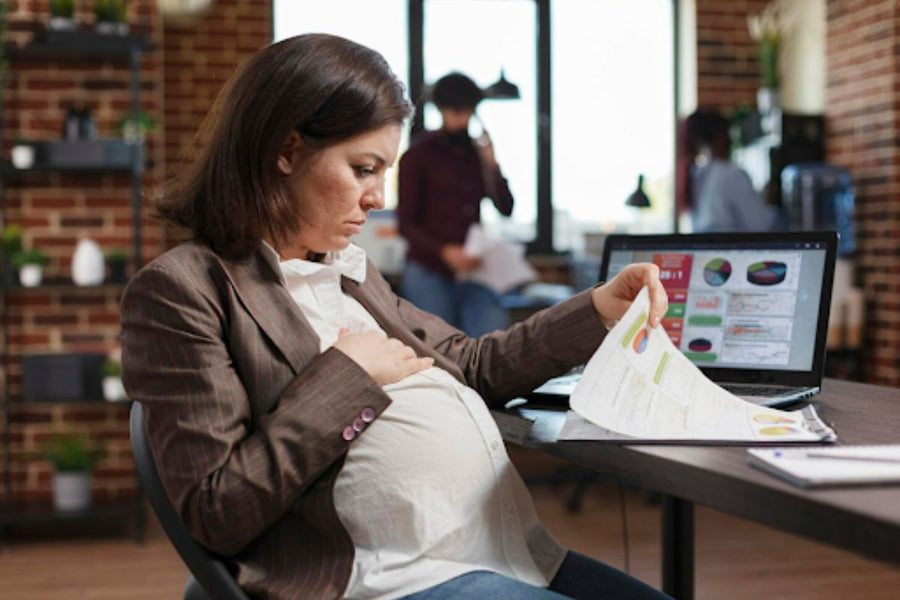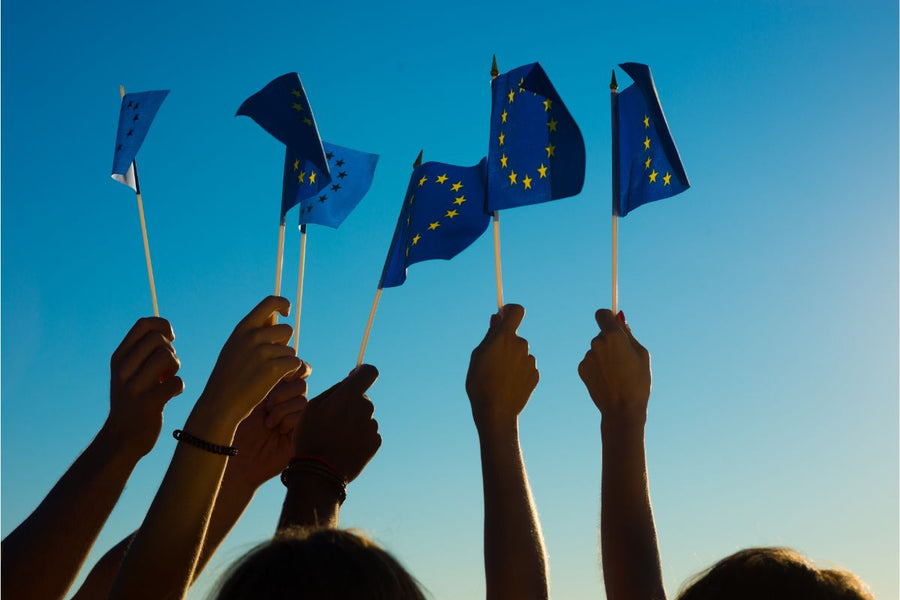Breastfeeding is thought provoking and highly emotional. Today, nursing is considered quite intimate and personal. You might feel happiness and relief, or perhaps pain and sorrow when you think of it. Breastfeeding culture has changed over the decades from a communal experience to a highly private, hidden practice.
As we are coming to the end of our 2021 Breastfeeding Month, I wanted to dive into more in-depth comparison with one of our biggest markets, Ireland, and Finland. The challenges and baseline for breastfeeding in Finland have a very different outlook in Ireland. Or do they? As we've found out over the course of the past month, breastfeeding has numerous benefits for mums and babies.
However, despite all the benefits we can prove, some countries have fallen behind in the global breastfeeding initiatives. Let’s compare Ireland and Finland.
Finland is doing well with breastfeeding: rating third among countries with extended breastfeeding in the European Union, and the general consensus is heavily weighted on supporting mothers to breastfeed (even doing this too much). Ireland is somewhat different. On a scale of much breastfeeding to none at all, the Republic is nearing the very-little-breastfed-babies side.
In Irish maternity hospitals in 2019 the breastfeeding initiation rate is 62.3% (4% increase since 2016). In Finland, it’s around 95%. This means that 4/10 newborns are not brought to mum’s breast initially after birth, an experience guaranteed to nearly all Finnish babies. For some reason, reading this statistic makes me slightly uncomfortable. It sounds worse to say four babies don't get immediate cuddles, than to say that six babies do.
Further on, according to a WHO target, half of all babies should be breastfed after six months by 2022. According to 2019 statistics, only 13% of Irish babies are breastfed after six months. In Finland, the same number is almost six times higher (77%). For comparison, the European average is 25% and global average is 38%.
Furthermore, initiating breastfeeding depends on your socioeconomic status: In the National Maternity Hospital the rate is 78% and in Donegal it is 45%. While socioeconomic gap exists in Finland too, it’s far from this extent. Education and income truly matter. They mean better access to information, more confidence to make breastfeeding decisions, and often access to private lactation consultant support, if needed. And frankly, social security has a lot to do with this, I imagine.
Breastfeeding history in a glance
History of breastfeeding tells the history of society. It tells of beliefs, traditions, and thoughts, and allows us today to base modern advise on clinical knowledge built upon decades. We know breastfeeding is good for both, mum and baby, for various reasons.
History also tells us why some societies have been left far behind on breastfeeding practices.
The first maternity and child health clinics were opened in Finland in the 1920s. Around the same time a Finnish paediatrician wrote a book on child illness and nutrition, which quickly became a staple in every household. It included recipes for homemade milk substitutes, which were used until the 1960s. The first commercial breastmilk substitute became available in 1948, but long before this, in 1931, a breastmilk centre was established near the children’s hospital in Helsinki: preemies and sick infants were given breastmilk bought from mums with oversupply. Today, almost 60% of Finnish babies are given supplementary milk in hospital. Although this is a high number, almost all of it is donated milk.

In comparison, Neave’s Food was produced in Ireland since 1825, over 120 years before milk substitutes became commercially available in Finland. The company used all available marketing tools: endorsements from medical professionals and parents, even claiming it was used in Russian Imperial Court. Most of these were wildly inaccurate and misleading, and they definitely wouldn't hold in court today. But we've all seen ads for different formulas that toe that line of being in good taste: they're still being advertised as paediatrician recommended (Enfamil), guaranteeing a bright future for your baby (Aptamil), or being the best for little tummies (Milupa).
In 1902, Horlicks claimed that a child fed on their malted milk powder “will sleep well, grow well, and flourish exceedingly”. In 1903, an ad for Grape-Nuts declared that the life of a child whose stomach had been ruined by condensed milk, was only saved by a preparation made from the cereal. And St Ivels cheese in 1911 was said to have saved the life of a vomiting three-month-old infant when “nothing else would stay down”. An advertisement from 1919 proposed mixing Robinsons barley water with dried milk.
You see where I’m going with this: commercialism of breastmilk substitutes has sunk its claws deep into the Irish soil and tradition. Indeed, for decades formula was the empowering solution for women to bring the bread home. It liberated them from the necessity of staying at home with sole responsibility over feeding baby. It allowed them independence.
Let’s not forget the impact of the Roman Catholic Church either. Breastmilk substitute market is a €60bn year industry in Ireland which produces 13% of the world’s demand. The Catholic Church is a multibillion-euro organisation, too. A study from 2016 found a negative correlation between the proportion of Catholics and breastfeeding initiation rates in western countries. This correlation was consistent for within-country data for Ireland, France, the UK and Canada.
And despite looking, I’ve been unable to find a comparison for the Finnish maternity and child health clinics in Ireland. Most of the care seems to be left to your registered GP, visiting public health nurse, or initially your midwife. More or less, the responsibility of your child’s wellbeing is largely left to the mum, as is the responsibility to seek help from a private consultant if needed.
Despite both countries now aspiring to the WHO’s set goal of 80% breastfed babies, there is still a long way to go. But Finland is a great example of what policy and continued effort can accomplish: In the 1960s and ‘70s, when commercial breastmilk substitutes became more popular and available, the national recommendations breastfeeding were shortest ever. Contributing to this was also urbanisation, women entering the working force, and short maternity leave. They brought with them a more breastfeeding-negative culture, which we can see today in Ireland.
However, in the end of 1970s some policy decisions started to change this. Finnish mums got extended maternity leave, families’ social security benefits improved. Baby-friendly and Family-friendly Hospital Initiatives such as allowing mum to keep baby close 24/7 were implemented. Skin-to-skin immediately after birth has helped: more mums exclusively breastfeed, which indicates that all this has affected breastfeeding.
Today, every hospital in Finland has a donor milk bank. In Ireland, to my understanding, there is one milk bank located in Northern Ireland that supplies all neonatal units in the Republic.
Read more: Bonny's Journey: From Breastfeeding Challenges to a Milk Donation Champion
Existing structures promote or prevent breastfeeding
While Finland subscribes to the social democratic welfare state, where many social protections (including a variety of family support schemes) are provided to all applicable citizens, Ireland is a more conservative, or corporatist welfare state. There is some social support for mums but fewer benefits to all citizens. Breastfeeding mums, for example, are entitled to breastfeeding breaks in the workplace with suitable facilities provided, or a reduction of one working hour per day (without pay loss) for up to 26 weeks. Maternity leave is 26 weeks. This legislation supports women’s reproductive labour in isolation from productive labour. It’s legislates for people who aren’t in the workplace.
Meanwhile Finnish mums have four months of maternity leave with following 6 months of parental leave. If needed or wanted, a childcare leave can be extended until your baby turns 3-years-old. That's a significant time you get to spend with your little one, but despite availability, not everyone has the means to remain at home even if they wished they could.
Today, most Irish mums who stop breastfeeding do so between two and six weeks postpartum. This is baby’s growth spurt time, and a normal newborn will feed somewhere in the 8 to 10 times a day plus a few night feeds. That’s normal. They will be hungry, and potentially fussy. Compare this age to a teenager and you’ll find it not so dissimilar: lots of food and moodiness! If you don’t know that’s normal, the other logical conclusion would be that baby is feeding so much because mum has a low supply of milk. Irish parents are lacking in education around normal newborn behaviour – education, that in Finland is provided through the Maternity and Baby clinics. Frequent feeding, waking, spit up, fussiness… all completely normal behaviours but leading many mums to stop breastfeeding because they believe something is wrong with them or baby.
Many women in Ireland reach out for supplementary support today. La Leche League, Cuidiú, and Friends of Breastfeeding, and IBCLC certified consultants are just examples of help available. But there are only 80 private consultants in all of Ireland. In 2020 there were over 55,000 births nationwide. That’s not a great equation.
Peer counselling used to be a given, when families compiled of many generations living in the same household. Breastfeeding was a spoken topic among women. Lactation consultants fill that purpose today. Meanwhile the Irish government doesn’t appear to be continuing The Breastfeeding Action Plan 2016 – 2021.
Keeping it real
Not all women can breastfeed. A serious illness or infection may prevent it. Certain medications or radiation therapy may prevent it. Or postpartum depression may prevent it. We need to talk about these things. Breastfeeding benefits society, not just mum and baby – and it is so much more than just the milk. It’s a live substance that changes in composition depending on time of day and from start to finish of a feed, and it’s tailormade for your baby’s needs. Breastfeeding is also your experience, baby’s experience, and society’s story. And history is so entangled with breastfeeding it’s unreal that we don’t talk more about breastfeeding.
We don’t talk about it, and we’ve gone out of our way to sexualise breastfeeding. Mums now feel ashamed or uncomfortable feeding their child in public. It makes women feel anxious - to feed their child.
And talking about feeding children, most countries have a long way to go to reach breastfeeding goals. While Finland is arguably doing better than Ireland, both are still far away from the WHO 80% exclusively breastfed babies target. But it’s reachable. The Finnish example of cultural and political will to give women the means to breastfeed if they so desire has proven effective. Now we can only hope Irish government packs the political will to make changes that will affect mums in a few decades – because breastfeeding is a process, and so is taking on the existing barriers that have been erected around breastfeeding in Ireland over the past 200 years.
Check out: Breast Pump Kit for nursing moms


